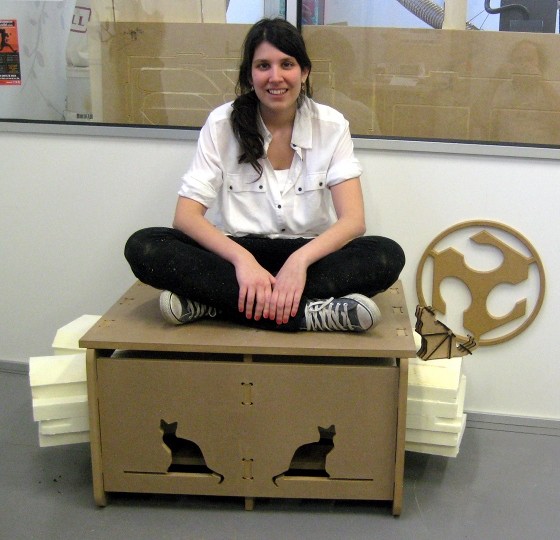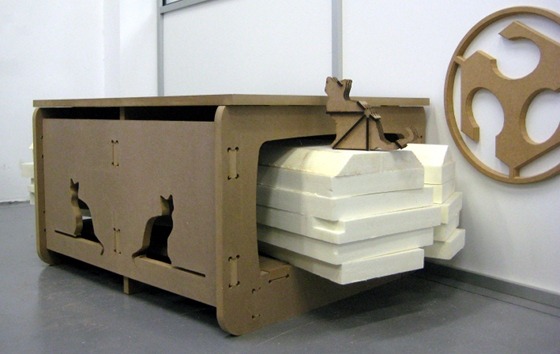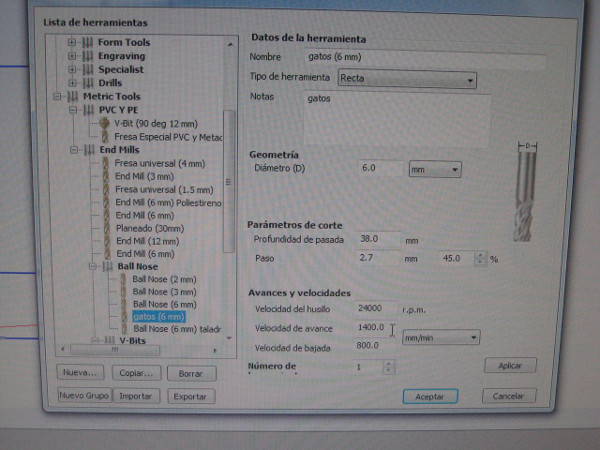Computer Controlled Machining (II) FOAM: An X tube mold

I have designed a cat friendly bench that is going to be made on DM and a X tube molde that is going to be made on FOAM. It is very important to have in mind the bed size of the machine and the size of the material one is machining. In this case the bed size is 2440x1220 mm, and the size of the materials are 2440x1220 mm for DM and 1220x660 for FOAM.
The documentation is here:
* CNC Machining (I) DM: A cat friendly bench (Click here)
* CNC Machining (II) FOAM: An X tube mold (Below)

An X tube mold for cats
Designing
- Material: 1220x660 mm FOAM .It is important to measure the thickness of your material with calipers => 39 mm:
- Joints: As the aim of this mold is to reproduce the volume of a tube, each panel of foam would be stick to the other panel in order to achive the volume of the tube in a X form
- Files to download:
2D FOAM MACHINING: configuration of the "Aspire" Software for CNC Machining (I)
Aspire is the software we use at Fab Lab Leon. It is neccesary to follow these steps and fill all gaps on the Aspire:
* "Material dimensions" ---> "Dimensiones del material" (what is the size of the material we are machining)
* "Material thickness" ---> "Espesor del material". For FOAM, we rest 0.2 mm to the thinckness measured with calipers. If it is a 40mm FOAM, this data on the software "Material thickness" will be 38mm.
* "Cero Z". Always "up"/"arriba"
* "X, Y". Place the (0,0) where your machine will start working.
*"Units" --->"Unidades". Set units, in this case mm.
*Click "Ok" and go to "3D view".
2D FOAM Machining (II). "Trayectorias de herramientas".
- "Cutting Parameters"--->"Parámetros de corte" ---> FOAM 2D dimension machining
- Feeds and Speeds for FOAM--->2D dimension machining
* How deep you cut--->"Profundidad de pasada" 38mm/2 = 19 mm
*"Step"--->"Paso" = 2.4 mm 40%
*"Spindle Speed"---> "Velocidad del husillo" = 24,000 RPM
*"Feed Rate"--->"Velocidad de avance" = 1200 mm/min
*"Plunge Rate"--->"Velocidad de bajada"= 700mm/min
Security:
*Listening to the machine, if it sounds like if it is in pain, something is wrong, how the cuts sounds is a good feedback.
*Keep next to the machine for the first 10 minutes, if something is wrong or the material starts burning you would notice it in time.
3D FOAM Machining (I). It is the same as in "2D FOAM MACHINING: configuration of the "Aspire" Software for CNC Machining (I)"
3D FOAM Machining (II). "Trayectorias de herramientas".
At Fab Lab Leon we are using Aspire to make the files for the CNC machine. It was very difficult to find a configuration of tool; feed and speed that could do the work of this first part of the mold which is not just 2D dimension but 3D. I made around 5 diferent simulation before having sucdess with this one:

* In this case we use a ball end tool: "Ball Noise 6mm". This is the configuration of parameters that gave me the shorter time for machining:
- Cutting Parameters--->Parámetros de corte
- Feed& Speed--->Avances y velocidades
- "Ramps". Click on "Lenguetas" and chose "2mm grosor" and "3mm longitud".
*Profundidad de pasada 38.0 mm
*Paso = 2.7 mm 45%
*Spindle Speed---> Velocidad del husillo= 24000 rpm
*Feed Rate--->Velocidad de avance= 1400 mm/min
*Plunge Rate--->Velocidad de bajada= 800mm/min

To do not forget
*If your tool is 6mm diameter, the distances between cutting paths should be broader than 6 mm.
*Always make a simulation of how long is the work going to take. At Fab Lab Leon is the half of the time the simulation is showing.